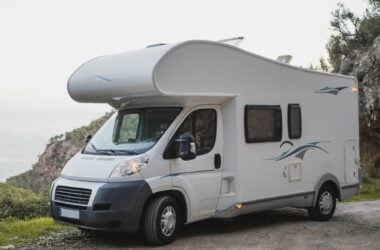Most people intuitively understand that a climate-controlled storage unit is more expensive than non-climate-controlled storage space. When deciding on the perfect storage unit size, you’ll have a difficult question to answer: Is a climate-controlled storage space really necessary?
The truth is that yes, there are times when climate-controlled storage is worth the price.
However, in some situations, you would be better off saving the money you would spend on climate-controlled storage and putting it toward something else, such as a high-grade self-storage lock.
When asking yourself, “Do I need climate-controlled storage?” consider the following six situations where paying for temperature- and humidity-regulated storage is worth the extra cost.
Scenario #1: You’re Storing for 3 + Months
The longer you store items, the more they’ll be exposed to seasonal changes in humidity and temperature. In much of the U.S., that means muggy, damp summers and cold, dry winters.
Climate-controlled indoor storage units are worth the extra cost once the storage period goes beyond the three-month mark. If your timeline includes more than one season between move-in and move-out, using climate control could cost less than replacing belongings damaged by heat, cold, or moisture.
- Short-term storage (under 90 days): A standard unit is usually fine for hardy household goods such as plastic patio furniture, metal tools, or sealed totes.
- Long-term storage (90 days +): Every extra month raises the odds that triple-digit temperatures, cold, or damp air will sneak in and warp wood, split leather, corrode electronics, or turn fabrics musty.
Scenario #2: You Aren’t on a Budget
A climate-controlled storage unit is better than a standard storage unit in more ways than one. Your items won’t have to deal with temperature and humidity fluctuations, and you’ll likely experience fewer issues as a result.
If you have the money for climate control, invest in it.
Depending on your location, the facility type (indoor vs. drive-up), the unit size, and availability, you’ll pay 20 to 50% more on average for climate-controlled storage.
| Unit Size | Avg. Standard Rate | Avg. Climate‑Controlled Rate |
| 5′ × 5′ | $65 | $85 |
| 5′ × 10′ | $95 | $120 |
| 10′ × 10′ | $135 | $170 |
| 10′ × 15′ | $175 | $220 |
| 10′ × 20′ | $225 | $285 |
| 10′ × 30′ | $300 | $380 |
Scenario #3: You Live In an Area With High Humidity
An average relative humidity above 60 percent is the perfect breeding ground for mold.
However, not all areas of the country are at high risk of mold-related issues; they’re most common in areas close to large bodies of water. Gulf‑coast states, much of the Southeast, the Pacific Northwest, and lake‑effect regions fall within that zone.
In traditional storage facilities, these high levels of humidity could lead to the following consequences:
- Paper curls and sticks together
- Metal grows a coat of rust.
- Upholstery can develop a damp, mildew-like smell. (Imagine the smell of an abandoned, unfinished basement.)
Climate-controlled facilities typically maintain humidity levels near 50–55 per cent, which is low enough to prevent mildew from forming. If you aren’t sure of your relative average humidity, here are some examples from big cities.
| City | Average Relative Humidity (%) |
| New Orleans, LA | 75% |
| Miami, FL | 74% |
| Houston, TX | 75% |
| Charleston, SC | 74% |
| Seattle, WA | 73% |
| Atlanta, GA | 68% |
| Chicago, IL | 70% |
| New York, NY | 63% |
| Phoenix, AZ | 36% |
Scenario #4: You Live In an Area Prone to Extreme Temperatures
Extreme temperatures, both extreme heat and extreme cold, can also negatively impact the belongings in your self-storage units.
Heat waves can lead to temperatures above 90°F, and cold snaps usually hover below 32°F. Both can cause issues.
- Above 90 °F: adhesives soften, candles liquefy, batteries leak, and electronics overheat.
- Below 32 °F: plastics become brittle, paint separates, and LCD screens crack.
A climate‑controlled unit is generally kept between 55°F and 85°F year‑round. When paying for climate-controlled storage, confirm the temperature the facility maintains for its units throughout the year. While the temperature may fluctuate, your belongings should be safe from damage as long as they stay within this temperature range.
Scenario #5: You’re Storing Furniture, Electronics, and Other High‑Value Items
What are you currently storing in your unit (or what do you plan to store)? Some people need a storage unit during their moving process, while others are looking for a safe place for some of their most prized possessions.
Ultimately, you will need to consider the costs of the items you are storing. In most cases, the cost of replacing these items will far exceed the extra 20-50% you’ll spend on a climate-controlled storage unit.
If a special piece of furniture passed down through generations starts to warp or a high-end gaming PC no longer turns on due to climate-related issues, you’ll regret not paying for the climate-controlled unit.
| Item Category | Avg. Replacement Cost | Added Cost for 5′ × 10′ Climate Unit (12 mo.) |
| Leather sofa | $1,800 | $300 |
| 65″ OLED TV | $1,400 | $300 |
| Vintage vinyl collection | $900 | $300 |
| Queen mattress & box spring | $1,200 | $300 |
Scenario #6: You’re Worried About Your Items Molding
Mold spores just need moisture, warmth, and organic material (wood, paper, fabric) to bloom. Unprotected surfaces run the following risks:
- Spores can germinate within 24–48 hours.
- Porous items, such as mattresses and books, may never be fully restored.
- Professional remediation will run you anywhere between $10 and $25 per square foot, which is often more than the item is worth.
A climate-controlled unit addresses the root cause (humidity) and maintains steady airflow, preventing mold from reaching a point where it causes damage.
Scenario #7: You’re Generally Nervous About Storing Your Belongings in a Storage Unit
It’s tough to load a truck full of your belongings, cart them to a storage unit, and walk away. These are some of your most prized possessions, and now, you have to leave them in the hands of some nameless storage facility.
In this situation, the premium for climate-controlled storage is worth it simply for peace of mind. You won’t have to check the forecast or worry about the length of time your belongings are in the unit and what could happen to them.
If you aren’t willing to spend the additional 20-50%, consider a storage option through Neighbor. On average, Neighbor renters spend approximately 30% less than the market rate for any storage unit size.
What Items Do Not Need Temperature-Controlled Storage Units?
Not all items will be damaged by extreme temperature fluctuations and lack of humidity control; some may be able to be stored in a non-climate-controlled storage unit without running the risk of damage.
A general rule of thumb is that if you’re already storing these items in your garage, then heated and air-conditioned storage units are likely unnecessary. These are likely non-temperature-sensitive items that can withstand a non-climate-controlled unit.
Here are a few prime examples of items that can (likely) endure a harsh winter or brutal summer in a non-climatized unit:
Outdoor and garage equipment: Lawn mowers, shovels, gardening tools, camping gear, and plastic furniture are made to withstand the elements.
Plastic storage bins: When sealed properly, these protect contents from moisture and pests.
Dishes, cookware, and general kitchenware: Non-sensitive items that won’t warp or corrode.
Tools and hardware: Hand tools and basic supplies hold up fine in standard storage units.
Miscellaneous household goods: Lamps, plastic décor, or small furniture that isn’t fabric-covered.
What Items Need Temperature-Controlled Storage Units
If it’s sensitive to heat, cold, or moisture, it probably needs climate control. A good thing to think about when choosing the right storage unit is whether you would hesitate to leave the item in your attic or basement. If the answer is yes, then a storage unit with a stable or constant temperature is important.
Here are a few items that are worth the splurge on climatized storage:
Furniture with wood, leather, or upholstery: Prone to warping, cracking, or absorbing moisture.
Electronics and appliances: Heat and humidity can damage internal components.
Paper goods and artwork: Includes books, documents, photos, important documents, and canvas pieces.
Collectibles and media: Vinyl records, family heirlooms, comics, wine, and anything you’d want to preserve long term.
Textiles and bedding: Fabrics can mold or hold odors if stored in damp conditions.
Musical instruments and candles: Sensitive to both temperature swings and humidity.
Final Thoughts
Whether you’ve decided on a climate-controlled storage unit or a traditional unit, consider Neighbor.com a peer-to-peer storage marketplace. Here, you can find climate-controlled storage options in your neighborhood.
While climate-controlled options are typically still more expensive, you can store your items within a one-mile radius of your residence. You’ll save yourself the time (and gas money) spent driving to some remote storage facility.







